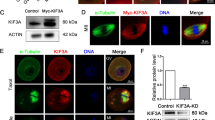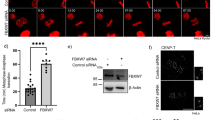Abstract
High-fidelity chromosome segregation during mitosis requires kinetochores, protein complexes that assemble on centromeric DNA and mediate chromosome attachment to spindle microtubules. In budding yeast, phosphoinositide-specific phospholipase C (Plc1p encoded by PLC1 gene) is important for function of kinetochores. Deletion of PLC1 results in alterations in chromatin structure of centromeres, reduced binding of microtubules to minichromosomes, and a higher frequency of chromosome loss. The mechanism of Plc1p’s involvement in kinetochore activity was not initially obvious; however, a testable hypothesis emerged with the discovery of the role of inositol polyphosphates (InsPs), produced by a Plc1p-dependent pathway, in the regulation of chromatin-remodeling complexes. In addition, the remodels structure of chromatin (RSC) chromatin-remodeling complex was found to associate with kinetochores and to affect centromeric chromatin structure. We report here that Plc1p and InsPs are required for recruitment of the RSC complex to kinetochores, which is important for establishing proper chromatin structure of centromeres and centromere proximal regions. Mutations in PLC1 and components of the RSC complex exhibit strong genetic interactions and display synthetic growth defect, altered nuclear morphology, and higher frequency of minichromosome loss. The results thus provide a mechanistic explanation for the previously elusive role of Plc1p and InsPs in kinetochore function.





Similar content being viewed by others
References
Baetz KK, Krogan NJ, Emili A, Greenblatt J, Hieter P (2004) The ctf13–30/CTF13 genomic haploinsufficiency modifier screen identifies the yeast chromatin remodeling complex RSC, which is required for the establishment of sister chromatid cohesion. Mol Cell Biol 24:1232–1244
Bunce MW, Bergendahl K, Anderson RA (2006) Nuclear PI(4, 5)P(2): a new place for an old signal. Biochim Biophys Acta 1761:560–569
Cairns BR (2005) Chromatin remodeling complexes: strength in diversity, precision through specialization. Curr Opin Genet Dev 15:185–190
Cairns BR, Lorch Y, Li Y, Zhang M, Lacomis L, Erdjument-Bromage H, Tempst P, Du J, Laurent B, Kornberg RD (1996) RSC, an essential, abundant chromatin-remodeling complex. Cell 87:1249–1260
Camahort R, Li B, Floresw L, Swanson SK, Washburn MP, Gerton JL (2007) Scm3 is essential to recruit the histone H3 variant Cse4 to centromeres and to maintain a functional kinetochore. Mol Cell 26:853–865
Cheeseman IM, Drubin DG, Barnes G (2002) Simple centromere, complex kinetochore: linking spindle microtubules and centromeric DNA in budding yeast. J Cell Biol 157:199–203
Cumberledge S, Carbon J (1987) Mutational analysis of meiotic and mitotic centromere function in Saccharomyces cerevisiae. Genetics 117:203–212
DeLillo N, Romero C, Lin H, Vancura A (2003) Genetic evidence for a role of phospholipase C at the budding yeast kinetochore. Mol Genet Genomics 269:261–270
Doheny KF, Sorger PK, Hyman AA, Tugendreich S, Spencer F, Hieter P (1993) Identification of essential components of the S. cerevisiae kinetochore. Cell 73:761–774
Du J, Nasir I, Benton BK, Kladde MP, Laurent BC (1998) Sth1p, a Saccharomyces cerevisiae Snf2p/Swi2p homolog, is an essential ATPase in RSC and differs from Snf/Swi in its interactions with histones and chromatin-associated proteins. Genetics 150:987–1005
Espelin CW, Simons KT, Harrison SC, Sorger PK (2003) Binding of the essential Saccharomyces cerevisiae kinetochore protein Ndc10p to CDEII. Mol Biol Cell 14:4557–4568
Fitzgerald-Hayes M, Clarke L, Carbon J (1982) Nucleotide sequence comparisons and functional analysis of yeast centromere DNAs. Cell 29:235–244
Gaudet A, Fitzgerald-Hayes M (1987) Alterations in the adenine-plus-thymine-rich region of CEN3 affect centromere function in Saccharomyces cerevisiae. Mol Cell Biol 7:68–75
Geng F, Cao Y, Laurent BC (2001) Essential roles of Snf5p in Snf–Swi chromatin remodeling in vivo. Mol Cell Biol 21:4311–4320
Guha N, Desai P, Vancura A (2007) Plc1p is required for SAGA recruitment and derepression of Sko1p-regulated genes. Mol Biol Cell 18:2419–2428
He X, Asthana S, Sorger PK (2000) Transient sister chromatid separation and elastic deformation of chromosomes during mitosis in budding yeast. Cell 101:763–775
Hegemann JH, Fleig UN (1993) The centromere of budding yeast. Bioessays 15:451–460
Hegemann JH, Shero JH, Cottarel G, Philippsen P, Hieter P (1988) Mutational analysis of centromere DNA from chromosome VI of Saccharomyces cerevisiae. Mol Cell Biol 8:2523–2535
Hieter P, Pridmore D, Hegemann JH, Thomas M, Davis RW, Philippsen P (1985) Functional selection and analysis of yeast centromeric DNA. Cell 42:913–921
Hsu JM, Huang J, Meluh PB, Laurent BC (2003) The yeast RSC chromatin-remodeling complex is required for kinetochore function in chromosome segregation. Mol Cell Biol 23:3202–3215
Huang J, Hsu JM, Laurent BC (2004) The RSC nucleosome-remodeling complex is required for Cohesin’s association with chromosome arms. Mol Cell 13:739–750
Kobor MS, Venkatasubrahmanyam S, Meneghini MD, Gin JW, Jennings JL, Link AJ, Madhani HD, Rine J (2004) A protein complex containing the conserved Swi2/Snf2-related ATPase Swr1p deposits histone variant H2A.Z into euchromatin. PLoS Biol 2:E131
Krogan NJ, Baetz K, Keogh MC, Datta N, Sawa C, Kwok TC, Thompson NJ, Davey MG, Pootoolal J, Hughes TR, Emili A, Buratowski S, Hieter P, Greenblatt JF (2004) Regulation of chromosome stability by the histone H2A variant Htz1, the Swr1 chromatin remodeling complex, and the histone acetyltransferase NuA4. Proc Natl Acad Sci USA 101:13513–13518
Lechner J, Carbon J (1991) A 240 kD multisubunit protein complex, CBF3, is a major component of the budding yeast centromere. Cell 64:717–725
Lee Y-S, Mulugu S, York JD, O’Shea EK (2007) Regulation of a cyclin-CDK–CDK inhibitor complex by inositol pyrophosphates. Science 316:109–112
Lin H, Choi JH, Hasek J, DeLillo N, Lou W, Vancura A (2000) Phospholipase C is involved in kinetochore function in Saccharomyces cerevisiae. Mol Cell Biol 20:3597–3607
Lipford JR, Bell SP (2001) Nucleosomes positioned by ORC facilitate the initiation of DNA replication. Mol Cell 7:21–30
McAinsh AD, Meraldi P, Draviam VM, Toso A, Sorger PK (2006) The human kinetochore proteins Nnf1R and Mcm21R are required for accurate chromosome segregation. EMBO J 25:4033–4049
McGrew J, Diehl B, Fitzgerald-Hayes M (1986) Single base-pair mutations in centromere element III cause aberrant chromosome segregation in Saccharomyces cerevisiae. Mol Cell Biol 6:530–538
Meluh PB, Yang P, Glowczewski L, Koshland D, Smith MM (1998) Cse4p is a component of the core centromere of Saccharomyces cerevisiae. Cell 94:607–613
Mizuguchi G, Xiao H, Wisniewski J, Smith MM, Wu C (2007) Nonhistone Scm3 and histones CenH3–H4 assemble the core of centromere-specific nucleosomes. Cell 129:1153–1164
Mulugu S, Bai W, Fridy PC, Bastidas RJ, Otto JC, Dollins DE, Haystead TA, Ribeiro AA, York JD (2007) A conserved family of enzymes that phosphorylate inositol hexakisphosphate. Science 316:106–109
Ng R, Carbon J (1987) Mutational and in vitro protein-binding studies on centromere DNA from Saccharomyces cerevisiae. Mol Cell Biol 7:4522–4534
Ng HH, Robert F, Young RA, Struhl K (2002) Genome-wide location and regulated recruitment of the RSC nucleosome-remodeling complex. Genes Dev 16:806–819
Nguyen PH, Hasek J, Kohlwein SD, Romero C, Choi JH, Vancura A (2005) Interaction of Pik1p and Sjl proteins in membrane trafficking. FEMS Yeast Res 5:363–371
Odom AR, Stahlberg A, Wente SR, York JD (2000) A role for nuclear inositol 1, 4, 5-trisphosphate kinase in transcriptional control. Science 287:2026–2029
Ortiz J, Stemmann O, Rank S, Lechner J (1999) A putative protein complex consisting of Ctf19, Mcm21, and Okp1 represents a missing link in the budding yeast kinetochore. Genes Dev 13:1140–1155
Payne WE, Fitzgerald-Hayes M (1993) A mutation in PLC1, a candidate phosphoinositide-specific phospholipase C gene from Saccharomyces cerevisiae, causes aberrant mitotic chromosome segregation. Mol Cell Biol 13:4351–4364
Pearson CG, Maddox PS, Salmon ED, Bloom K (2001) Budding yeast chromosome structure and dynamics during mitosis. J Cell Biol 152:1255–1266
Pinto I, Winston F (2000) Histone H2A is required for normal centromere function in Saccharomyces cerevisiae. EMBO J 19:1598–1612
Romero C, Desai P, DeLillo N, Vancura A (2006) Expression of FLR1 transporter requires phospholipase C and is repressed by mediator. J Biol Chem 281:5677–5685
Saiardi A, Bhandari R, Resnick AC, Snowman AM, Snyder SH (2004) Phosphorylation of proteins by inositol pyrophosphates. Science 306:2101–2105
Saiardi A, Resnick AC, Snowman AM, Wendland B, Snyder SH (2005) Inositol pyrophosphates regulate cell death and telomere length through phosphoinositide 3-kinase-related protein kinases. Proc Natl Acad Sci USA 102:1911–1914
Sekinger EA, Moqtaderi Z, Struhl K (2005) Intrinsic histone-DNA interactions and low nucleosome density are important for preferential accessibility of promoter regions in yeast. Mol Cell 18:735–748
Sharp JA, Franco AA, Osley MA, Kaufman PD (2002) Chromatin assembly factor I and Hir proteins contribute to building functional kinetochores in S. cerevisiae. Genes Dev 16:85–100
Shen X, Xiao H, Ranallo R, Wu WH, Wu C (2003) Modulation of ATP-dependent chromatin-remodeling complexes by inositol polyphosphates. Science 299:112–114
Sherman F (1991) Getting started with yeast. Methods Enzymol 194:3–21
Simpson RT (1990) Nucleosome positioning can affect the function of a cis-acting DNA element in vivo. Nature 343:387–389
Singer-Kruger B, Nemoto Y, Daniell L, Ferro-Novick S, De Camilli P (1998) Synaptojanin family members are implicated in endocytic membrane traffic in yeast. J Cell Sci 111:3347–3356
Smith MM, Yang P, Santisteban MS, Boone PW, Goldstein AT, Megee PC (1996) A novel histone H4 mutant defective in nuclear division and mitotic chromosome transmission. Mol Cell Biol 16:1017–1026
Steger DJ, Haswell ES, Miller AL, Wente SR, O’Shea EK (2003) Regulation of chromatin remodeling by inositol polyphosphates. Science 299:114–116
Stoler S, Rogers K, Weitze S, Morey L, Fitzgerald-Hayes M, Baker RE (2007) Scm3, an essential Saccharomyces cerevisiae centromere protein required for G2/M progression and Cse4 localization. Proc Natl Acad Sci USA 104:10571–10576
Strahl T, Thorner J (2007) Synthesis and function of membrane phosphoinositides in budding yeast, Saccharomyces cerevisiae. Biochim Biophys Acta 1771:353–404
Tanaka T, Cosma MP, Wirth K, Nasmyth K (1999) Identification of cohesin association sites at centromeres and along chromosome arms. Cell 98:847–858
Tsuchiya E, Hosotani T, Miyakawa T (1998) A mutation in NPS1/STH1, an essential gene encoding a component of a novel chromatin-remodeling complex RSC, alters the chromatin structure of Saccharomyces cerevisiae centromeres. Nucleic Acids Res 26:3286–3292
Westermann S, Drubin DG, Barnes G (2007) Structures and functions of yeast kinetochore complexes. Annu Rev Biochem 76:563–591
Winey M, Mamay CL, O’Toole ET, Mastronarde DN, Giddings TH Jr, McDonald KL, McIntosh JR (1995) Three-dimensional ultrastructural analysis of the Saccharomyces cerevisiae mitotic spindle. J Cell Biol 129:1601–1615
Xue Y, Casnman JC, Lee CS, Nie Z, Yang D, Moreno GT, Young MK, Salmon ED, Wang W (2000) The human SWI/SNF-B chromatin-remodeling complex is related to yeast rsc and localizes at kinetochores of mitotic chromosomes. Proc Natl Acad Sci USA 97:13015–13020
York JD (2006) Regulation of nuclear processes by inositol polyphosphates. Biochim Biophys Acta 1761:552–559
York JD, Odom AR, Murphy R, Ives EB, Wente SR (1999) A phospholipase C-dependent inositol polyphosphate kinase pathway required for efficient messenger RNA export. Science 285:96–100
York SJ, Armbruster BN, Greenwell P, Petes TD, York JD (2005) Inositol diphosphate signaling regulates telomere length. J Biol Chem 280:4264–4269
Zhao K, Wang W, Rando OJ, Xue Y, Swiderek K, Kuo A, Crabtree GR (1998) Rapid and phosphoinositol-dependent binding of the SWI/SNF-like BAF complex to chromatin after T lymphocyte receptor signaling. Cell 95:625–636
Acknowledgments
We thank Drs Baetz, Hieter, Laurent, Kaufman, Measday, Rine, Stillman, Struhl, Wente, and York for strains and plasmids and members of Vancura laboratory and Dr Vancurova for helpful comments. This work was supported by grants from the National Institutes of Health (GM076075) to A. Vancura.
Author information
Authors and Affiliations
Corresponding author
Additional information
Communicated by M. Collart.
Electronic supplementary material
Below is the link to the electronic supplementary material.
Rights and permissions
About this article
Cite this article
Desai, P., Guha, N., Galdieri, L. et al. Plc1p is required for proper chromatin structure and activity of the kinetochore in Saccharomyces cerevisiae by facilitating recruitment of the RSC complex. Mol Genet Genomics 281, 511–523 (2009). https://doi.org/10.1007/s00438-009-0427-9
Received:
Accepted:
Published:
Issue Date:
DOI: https://doi.org/10.1007/s00438-009-0427-9




